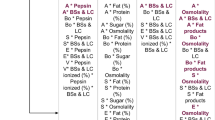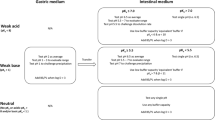Abstract
Purpose. The objective of this study was to develop a model to predict the extent to which bile salts can enhance the solubility of a drug, based on the physicochemical properties of the compound. The ability to predict bile salt solubilization of poorly soluble drugs would be a key component in determining which drugs will exhibit fed vs. fasted differences in drug absorption.
Methods. A correlation between the logarithm of the octanol/water partition coefficient [log P] of six steroidal compounds and their solubilities in the presence of various concentrations of sodium taurocholate at 37°C, log [SR] = 2.234 + 0.606 log [P] (r2 = 0.987) where SR is the ratio of the solubilization capacity of the bile salt to the solubilization capacity of water for the drug, was used to predict the solubility of five further compounds with diverse structures. The solubilities of the compounds in presence of sodium taurocholate were then measured.
Results. The predicted solubilities were within 10% of the experimentally observed solubilities for griseofulvin, cyclosporin A and pentazocine. The model overpredicted the solubility of phenytoin and diazepam in 15 mM sodium taurocholate solution by a factor of 1.33 and 1.62 respectively.
Conclusions. The expected increase in solubility as a function of bile salt concentration can be estimated on the basis of the partition coefficient and aqueous solubility of the compound.
Similar content being viewed by others
REFERENCES
J. P. Griffin. Drug interactions occurring during absorption from the gastrointestinal tract. Pharmac. Ther. 15:79–88 (1981).
A. Melander. Influence of food on the bioavailability of drugs. Clin Pharmacokinet. 3:337–351 (1978).
R. G. Crounce. Human pharmacology of griseofulvin: The effect of fat intake on gastrointestinal absorption. J. Invest. Dermatol. 37:529–532 (1961).
T. Hamaguchi, D. Shinkuma, T. Irie, Y. Yamanaka, Y. Morita, B. Iwamoto, K. Miyoshi, and N. Mizuno. Effect of a high-fat meal on the bioavailability of phenytoin in a commercial powder with a large particle size. Int. J. Clin. Pharmacol. Ther. Toxicol. 31(7):326–330 (1993).
W. N. Charman, M. C. Rogge, A. W. Boddy, and B. M. Berger. Effect of food and a monoglyceride emulsion formulation on danazol bioavailability. J. Clin. Pharmacol. 33:381–386 (1993).
O. Fausa. Duodenal bile acids after a test meal. Scand. J. Gastroent. 9:567–570 (1974).
A. Tangerman, A. vanSchaik, and E. W. vander Hook. Analysis of conjugated and unconjugated bile acids in serum and jejunal fluid of normal subjects. Clin. Chem. Acta. 159:123–132 (1986).
T. L. Peeters, G. Vantrappen and J. Janssens. Bile acid output and the interdigestive migrating motor complex in normals and in cholecysectomy patients. Gastroent. 79:678–681 (1980).
T. R. Bates, M. Gibaldi, and J. L. Kanig. Rate of dissolution of griseofulvin and hexoestrol in bile salt solutions. Nature. 210:1331–1333 (1966).
V. Bakatselou, R. Oppenheim, and J. Dressman. Solubilization and wetting effects of bile salts on the dissolution of steroids. Pharm. Res. 8:1461–1469 (1991).
L. J. M. Naylor. Dissolution mechanisms of poorly soluble compounds in simple and mixed micelle systems. Doctoral Thesis. The University of Michigan. (1993).
D. Shinkuma, T. Hamaguchi, M. Koboyashi, N. Mizuno, and Y. Noboru. Influence of bile on the gastrointestinal absorption of phenytoin in rats. Chem. Pharm. Bull. 33:5023–5027 (1985).
A. A. Noyes, and W. R. Whitney. The rate of solution of solid substances in their own solution. J. Am. Chem. Soc. 19:930–934 (1897).
H. Weintraub, and M. Gibaldi. Physiological surface active agents and drug absorption IV: Effect of premicellar concentrations of surfactant on dissolution rate. J. Pharm. Sci. 58:1368–1372 (1969).
H. Tomida, T. Yotsuyanagi, and K. Ikeda. Solubilization of steroid hormones by polyoxyethylene lauryl ether. Chem. Pharm. Bull. 26:2832–2837 (1978).
J. C. Caron, and B. Shroot. Determination of partition coefficients of glucocorticosteroids by high performance liquid chromatography. J. Pharm. Sci. 73:1703–1706 (1984).
A. Leo, C. Hansch, and D. Elkins. Partition coefficient and their uses. Chem. Rev. 71:525–616 (1971).
N. Taylor, A. E. Mark, P. Vallat, R. M. Brinne, B. Testa, and W. F. van Gunterent. Solvent-dependent conformation and hydrogen-bonding capacity of cyclosporine A: evidence from partition coefficients and molecular dynamics simulations. J. Med. Chem. 36:3757–3764 (1993).
T. D. Wilson. Pentazocine. In Analytical Profiles of Drug Substances. vol. 13, 1984, pp. 361–416.
P. A. Schwartz, C. T. Rhodes, and J. W. Cooper. Solubility and ionization characteristics of phenytoin. J. Pharm. Sci. 66:994–997 (1977).
J. Barrett, W. F. Smyth, and I. E. Davidson. An examination of acid-base equilibria of 1,4-benzodiazepines by spectrophotometry. J. Pharm. Pharmacol. 25:387 (1973).
A. Osol. Remington's Pharmaceutical Sciences. 16th edition. Mack Publishing Co., Easton, Pennsylvania, 1980.
M. C. Carey, and D. M. Small. Micelle formation by bile salts: Physical, chemical and thermodynamic conditions. Arch. Intern. Med. 130:506–527 (1972).
J. B. Dressman, R. R. Berardi, L. C. Dermentzoglou, T. L. Russell, S. P. Schmaltz, J. L. Barnett, and K. M. Jarvenpaa. Upper gastrointestinal (GI) pH in young, healthy men and women. Pharm. Res. 7:756–761 (1990).
D. Attwood and A. T. Florence. Surfactant Systems, Their Chemistry, Pharmacy and Biology, Chapman and Hall, London, 1983.
A. A. Ismail, M. Wafik Gouda, and M. M. Motawi. Micellar solubilization of barbiturates I. Solubilities of certain barbiturates in Polysorbates of varying hydrophobic chain length. J. Pharm. Sci. 59:220–224 (1970).
B. W. Barry and D. I. D. El Eini. Solubilization of hydrocortisone, dexamethasone, testosterone and progesterone by long chain polyoxyethylene surfactants. J. Pharm. Pharmacol. 28:210–218 (1976).
J. H. Collet and I. Koo. Interaction of substituted benzoic acids with polysorbate 20 micelles. J. Pharm. Sci. 64:1253–1255 (1975).
H. Tomida, T. Yotsuyanagi, and K. Ikeda. Solubilization of benzoic acid derivatives by polyoxyethylene lauryl ether. Chem. Pharm. Bull. 26:2824–2831 (1978).
K. M. S. Fahelelbom, R. F. Timoney, and O. I. Corrigan. Micellar solubilization of clofazimine analogues in aqueous solutions of ionic and nonionic surfactants. Pharm. Res. 10:631–634 (1993).
Author information
Authors and Affiliations
Rights and permissions
About this article
Cite this article
Mithani, S.D., Bakatselou, V., TenHoor, C.N. et al. Estimation of the Increase in Solubility of Drugs as a Function of Bile Salt Concentration. Pharm Res 13, 163–167 (1996). https://doi.org/10.1023/A:1016062224568
Issue Date:
DOI: https://doi.org/10.1023/A:1016062224568




